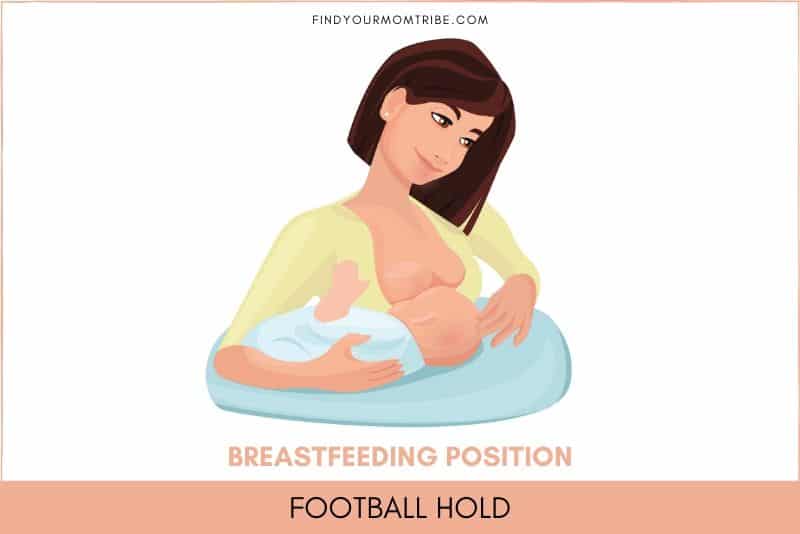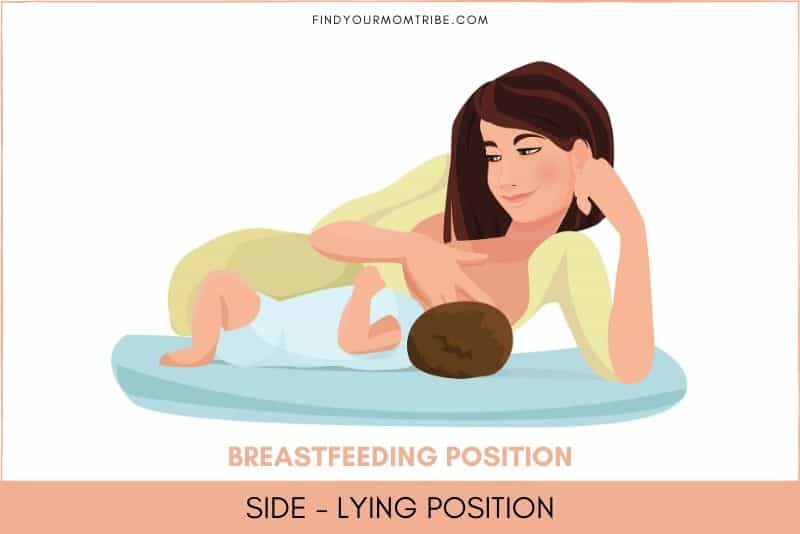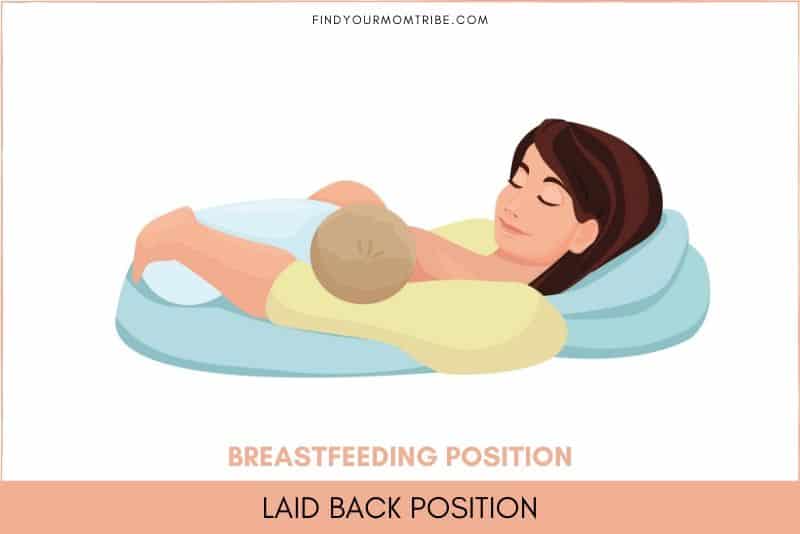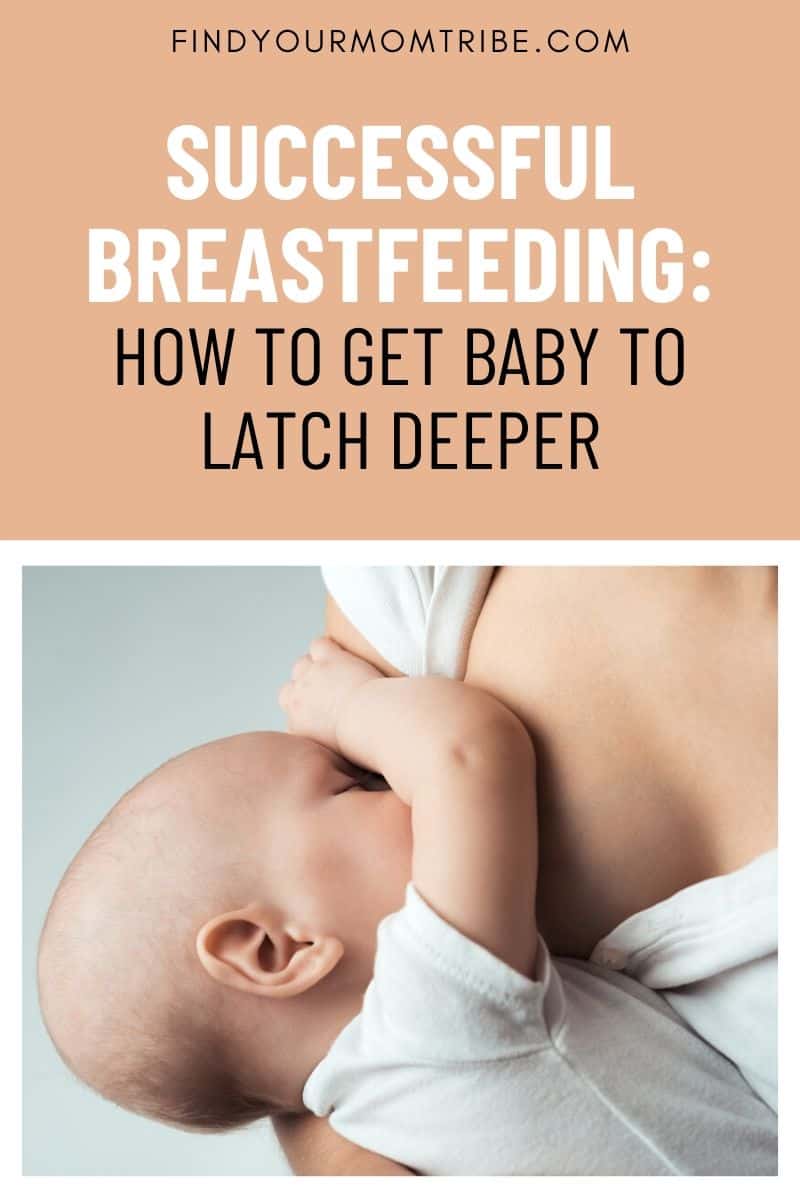Even though breastfeeding is an instinct, this doesn’t mean that all babies automatically know what to do during their first nursing sessions.
In fact, there are numerous tips on how to get a baby to latch deeper, which just shows you how common this is!
A deep latch equals a good latch. This means that the mother’s nipple and parts of her breast tissue are deep inside the baby’s mouth.
Knowing how to get a baby to latch deeper will ensure that he or she gets enough milk to grow into a healthy and happy baby.
What’s more, a deeper latch means a more comfortable breastfeeding experience for the mom, allowing her to continue nursing for as long as she would like without having to suffer from painful breastfeeding.
If you are not sure whether your baby has a poor latch or not, one of the first signs to look out for is severe pain in your nipples – this is a result of the baby’s gums clamping down on your nipple.
RELATED: Why Baby Won’t Latch And 15 Ways To Fix It
Luckily, there are many different nursing positions you can try to make breastfeeding the wonderful and painless experience it should be for every new mom!
How to get baby to latch deeper

One of the best methods to encourage a deeper latch is to lie your baby on your tummy.
The close contact between you and your little one will help the baby awaken their instinct to nurse.
There are different motions babies make when they are ready to eat, such as starting to bob their head, rooting, and opening their mouth.
Don’t wait until your little one starts crying, as this is a late indicator of hunger and it could be more difficult to get into a comfortable position with a very upset baby.
No matter which breastfeeding position you choose, there are a few steps you can take to make sure your baby is latched in a way that’s comfortable for you and allows the baby to get enough milk.
While holding your baby in one arm, use the other to hold your breast so that your index finger is below the nipple and the thumb is above your nipple.
Encourage your baby to open their mouth in a gape as this will ensure that the nipple and breast tissue goes deep into their mouth (the baby’s lips will also close over all or a part of the areola).
With time, you will figure out what is the best nursing position for you and your little one.
Remember that it’s always best to perfect one position, rather than to switch back and forth between different ones.
The football hold

The football or clutch position is called this because the mom holds the baby like a football while he or she is feeding.
The baby’s head rests against the back of your hand, while the rest of the baby’s body rests against the length of your arm.
This position is especially well-suited for moms who had a C-section because the baby won’t be in any contact with the scar.
The cradle hold

Moms love this nursing position because it allows them to gently hold or cradle the baby against their tummy with their arm, while the baby’s head is supported by their forearm.
You can even use a pillow to lift the baby up to make sure that their mouth is right in front of your nipple.
The cross-cradle hold

The cross-cradle is a slightly modified version of the cradle hold, where you will support the baby’s head with your hand but the baby will be laying on a nursing pillow.
This is a great position to start breastfeeding in because you can gently guide your baby’s head in the proper direction, while also keeping him or her close to your body.
The side-lying position

While breastfeeding at night, many moms find this to be the best position for the baby and themselves since they don’t have to leave the bed to nurse, and it doesn’t disturb their precious sleep as much as getting up does.
In this position, you lie on your side, facing your baby while cradling him or her with your arm.
While nursing in the side-lying position, remember to remove any extra blankets or sheets that could be dangerous to your little one.
Even though it is one of the most comfortable nursing positions, it takes some practice to get right, so practice it during the daytime first before trying it out in the middle of the night.
The laid-back position

The laid-back breastfeeding position is very comfortable for both mom and baby, as you can lean back in a chair or in bed and place your little one on your chest.
Use your hand to keep the baby’s bottom in place and their body firmly against yours.
Encourage your baby to open their mouth by rubbing their cheek or the tip of your nipple on their lips, until the baby latches.
How do I know that my baby’s latch has improved?

Remember, though, that it might take some time for your little one to get completely comfortable with nursing, so continuing to practice is important.
But if you haven’t been making progress, in spite of all the different deep latch techniques and positions you have tried, speak to a professional who can give you tailored advice to help improve your breastfeeding experience.
What is a shallow latch?

Babies who have no trouble breastfeeding latch on to both the nipple and the areola in a way that allows the nipple to be placed towards the back of the baby’s palate.
In addition, the baby’s nose should be touching the upper side of your breast while the baby’s chin should be touching the bottom of your breast.
A shallow latch, on the other hand, causes the baby to clamp down on the nipple so that it is tightly pressed in the baby’s mouth, causing pain for the mom.
In fact, one of the first symptoms of a poor latch is nipple pain, which can be accompanied by nipples that are cracked and even bleed.
While nipple pain and sore nipples should be expected in the first few weeks of nursing (usually 2 weeks), it should only be felt while the baby is breastfeeding and not all the time.
The nipples can also start getting a flatter shape, or look crushed if your baby has a shallow latch.
But your little one can also experience certain symptoms, such as poor weight gain.
For example, many moms are confused and scared of how little weight their baby is gaining, despite them breastfeeding very often.
What they don’t know is that the baby’s latch isn’t allowing him or her to get enough breast milk during their nursing sessions, which is why the baby isn’t developing as fast as he or she should.
Another common sign of a poor latch is noises that sound like clicking, so if you hear them, gently remove your breast from the baby’s mouth and try again.
What are the causes of a shallow latch?

While there are many different positions that can improve how a baby latches, it’s important to know that you should try out different ones to see which one works best for your baby.
Your baby’s latch can also be affected by something called nipple confusion, which happens when a baby can’t get a good latch as a result of using bottles or pacifiers (not all babies develop nipple confusion, however).
Sucking on a silicone or rubber nipple on a bottle is very different to the “real deal”, not to mention that the milk flow in a bottle can be much faster than when nursing.
Some babies can develop a preference for bottles and have trouble latching onto a breast again.
The best way to avoid nipple confusion is to avoid bottles and pacifiers altogether for as long as possible, although this is not a viable alternative for many moms who must go back to work or would simply like for someone else to feed the baby.
In this case, finding bottles that closely imitate the breastfeeding experience can be helpful.
Alternatively, you can just hold off on introducing bottles until you’re sure your little one is completely comfortable when nursing.
Premature babies can also struggle with breastfeeding, as they are smaller than babies who were carried to term and their mouth can’t properly latch onto a breast.
Sometimes the reason behind a poor latch lies in the shape of the mom’s nipples.
Women who have flat nipples often experience issues with breastfeeding as it’s difficult for the baby to suck on a nipple that doesn’t stick out.
If you find that you do have flat nipples, talk to an international board-certified lactation consultant (IBCLC) about trying nipple shields, which allow your little one to nurse more easily.
Engorgement, a condition when the mom’s breasts become overfilled with milk, can also make it difficult for a baby to get a deep latch.
To treat engorgement, make sure to breastfeed regularly and if your baby can’t nurse yet, you can start using a breast pump and feed your milk to your baby through a bottle.
This way, your little one will still get all the nutrition found in breast milk and your breasts won’t get engorged.
In addition, it will prevent low milk supply as you will be emptying your breasts regularly.
But for women who have naturally bigger breasts, it can also be difficult to properly adjust themselves and find a good feeding position even if they’re not experiencing engorgement.
Some babies are also born with conditions that make nursing difficult, such as tongue-tie, which means that the baby’s tongue is more closely connected to their mouth.
As a result, they can’t stick it far out enough for a good latch.
Finally, it’s important to remember that breastfeeding should be a pleasant experience for both mom and baby.
There are infants who will reject feedings when they are crying, so calming them down first and taking them to a quiet room with fewer stimuli will soothe them enough to breastfeed.
To wrap up

As nipple pain is one of the biggest signs that a baby has a poor latch, advice on how to get a baby to latch deeper is incredibly important and can help moms everywhere keep nursing their little one and providing them with all the nutrients they need.
While a baby’s latch might not improve overnight and lots of trial and error should be expected, remember that it’s also okay to ask for help from a lactation consultant if you are really struggling with breastfeeding.
And because each mom and baby are unique, the answer to how to get a baby to latch deeper will vary from family to family, so it’s important to stay positive – sooner or later, you will find a solution that works for you and your little one!
READ NEXT: 6 Signs Of Ovulation While Breastfeeding And How To Spot Them
Like this post? Please share or pin it for later. You can also stay in the loop and follow us on Facebook, Instagram or Pinterest.

This post contains affiliate links. Please see our full disclosure for more info.

